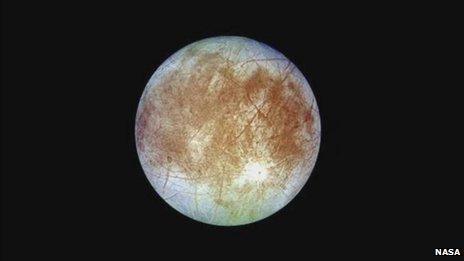Is Nasa looking in the wrong place for life?
- Published
- comments

The world's leading space agency, Nasa, has an ambitious new Grand Plan: to "identify, capture and relocate" an asteroid.
Outlining the Agency's $17.7 billion budget proposal for 2014, Nasa administrator Charles Bolden said the mission would ensure the United States remained in the forefront of space exploration and scientific discovery for years to come.
Nasa 'missing out on basic science exploration'
"This mission represents an unprecedented technological feat that will lead to new scientific discoveries and technological capabilities and help protect our home planet".
You can watch a video animation of the proposed mission here. But the scheme is already attracting criticism: Republican Congressman Lamar Smith - who chairs the House committee that will have to review Nasa's budget proposals - dismissed the plan to "lasso" an asteroid as "creative".
Nasa's need to court support - and funding - with eye-catching or inspiring schemes is understandable. But with so many on the go at one time there's mounting concern that the big showcase missions are diverting attention from the Agency's primary scientific goals.
"The Nasa programme is looking quite lop-sided at the moment" according to Professor Andrew Coates, the head of planetary science at UCL's Mullard Space Science Laboratory.
"They're doing Mars with Curiosity obviously, but they're also going back to Mars with Curiosity Two in 2020. Then there's the replacement for Hubble, the James Webb Space Telescope (JWST), which has been very expensive with lots of cost overruns, and now this asteroid mission. It sounds fantastic, but they're missing out on some of the basic science and exploration Nasa should be doing."
It's a view that's echoed within the Nasa family. Planetary scientists like Dr Robert Pappalardo at the Jet Propulsion Laboratory have grown increasingly frustrated as proposals to explore the further reaches of the solar system have been sidelined in favour of Mars and the JWST.
"For reasons I don't really understand the outer solar system, and the potential for life there, has not been a high priority".
And things look set to get worse. While the 2014 budget proposals include $100 million in seed money to get Nasa's asteroid mission up and running (the eventual cost will run to several billion dollars), yet again there's no money for the Europa Clipper Mission to survey Jupiter's moon.
It's a decision Bob Pappalardo finds hard to comprehend. If the question is life - and that's one of the most profound questions we can ask, he says - the answer is almost certainly not Mars or an asteroid, but rather the icy moons orbiting distant planets like Saturn and Jupiter.
"I worry that if Europa exploration is delayed, but then finally it happens some day, we might look back and say 'why didn't we do that sooner?' Imagine 50 years from now we get a lander there and find signs of life. All this time we'll have been looking in the wrong place".
But if Nasa's attention has been diverted, the European Space Agency is looking in some of the right places. It's JUpiter ICy moons Explorer, or JUICE, mission will survey three of the distant gas giant's moons looking to confirm the presence of liquid water beneath their frozen surfaces.
"What we want to understand is whether the moons of Jupiter have the environments you need to support life," says Imperial College's Professor Michele Dougherty, who's the lead investigator for the Magnetic Field Instrument, or magnetometer, which will fly on the JUICE Mission.
"You need there to be liquid water, you need there to be heat, you need stability over time and you need organic compounds. We think Ganymede Callisto and Europa have all of those, but we won't know until we get there."
The JUICE mission is set for launch in 2022 and should reach Jupiter in 2030. Not long to wait for perhaps the biggest scientific discovery since Copernicus proved that the earth goes round the sun - that we are not alone.